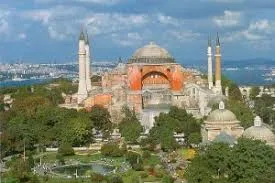
A historic museum in Istanbul. It was a basilica-planned patriarchal cathedral built by the Byzantine Emperor Justinian I. Jr. in the old city center on the historical peninsula of Istanbul between 532 and 537 AD. After the capture of Istanbul by the Turks in 1453, it was transformed by Sultan Mehmet the Conqueror. Since 1935 it has been serving as a museum. Haghia Sophia is a domed basilica type building which combines the basilica plan with the central plan in architectural terms and is considered as an important turning point in the history of architecture with the features of the dome passage and the supporting system.
The word "sofia" in the name of the building comes from the word sophos, which means "wisdom" in ancient Greek, not the name of any one. Thus, the name "aya sofya" means "holy wisdom" or "divine wisdom" and is considered one of the three qualities of God in the Orthodox sect. Hagia Sophia, ruled by Isidoros of Miletus and Anthemius of Tralles, it is said that about 10,000 workers have been working in the construction and that Justinian has spent a great deal of money on this business, a feature of this very old building is that some of the columns, doors and stones used in the construction were brought from buildings and temples.
During the Byzantine period Hagia Sophia had a great wealth of "sacred relics". One of these relics is the 15-meter-high Silver Iconostasis. The patriarchal church of the Patriarchate of Constantinople and Hagia Sophia, the center of the Orthodox Church for a thousand years, was founded in 1054 by Patriarch I. Mikhail Kiroularios' Pope IX. It has been witnessed by Leo to have been referred to by the exposition, which in general is considered to be the beginning of Schisma's separation of the Eastern and Western churches.